Our landing gear touches down with a gushing wake in Goose Bay, Labrador – “Goose” in local parlance. The thundering downpours that surround us are the reason why we arrive a day early. Getting weather-bound is a common occurrence while waiting for the final leg to the ancestral lands of the Northern Labrador Inuit, over 900 miles north of St John’s, Newfoundland. By morning though, the sun shines and our flight to the Torngat Mountains Base Camp and Research Station is a go.
Co-pilot Brody slams the stairs hatch shut and then climbs into the cockpit of our bright red 1960s-era Twin Otter. Soon, engines fire up, propellers whir. Partway, we’ll touch down in the remote Inuit outport of Nain to refuel, then onto the Cold War–era airstrip of Saglek Bay. The runway there is long enough for jets, but is now pretty much abandoned except for these Air Borealis flights. Other aircraft fly this route faster and smoother at higher altitudes, but during the three hours ahead, I’ll be grateful to linger over this mesmerizing geography.
Arriving in a wilderness with a complex history
Azure skies and the plane’s bright red wing contrast a lacework of rivers, estuaries, islands and coastal mountains below. Slowly the landscape seems to rise up beneath us as we approach Canada‘s tallest mountains east of the Rockies. Forests begin to disappear, revealing bald, ancient rock, craggy and striated by glaciers long gone – some of the oldest rock on earth dating back almost four billion years. Massive icebergs appear, likely originating from glaciers in Greenland. We spot our first polar bears, a mother leading her cub over a rocky mound of an island, seemingly afloat in the North Atlantic.
Exploring this wild wonderland is reason enough to come here, but it is not the most important. For certain, the tragic story of relocation of Indigenous peoples is all too familiar across Canada. Still, in this moment, there is so much I can’t begin to fully grasp about the impact of this story and the next chapter now unfolding. All this lies ahead — the personal stories of Labrador Inuit returning here to reclaim their roots, the work of visiting scientists fighting climate change alongside traditional Inuit Knowledge Keepers, the revelations of Inuit youth glimpsing for the first time how their grandparents and great-grandparents lived. And as we offload our gear in Saglek, I wonder too how I, as a traveler, will fit into all this. Am I just a privileged spectator? What can I contribute?
The answers are just a short helicopter ride away.
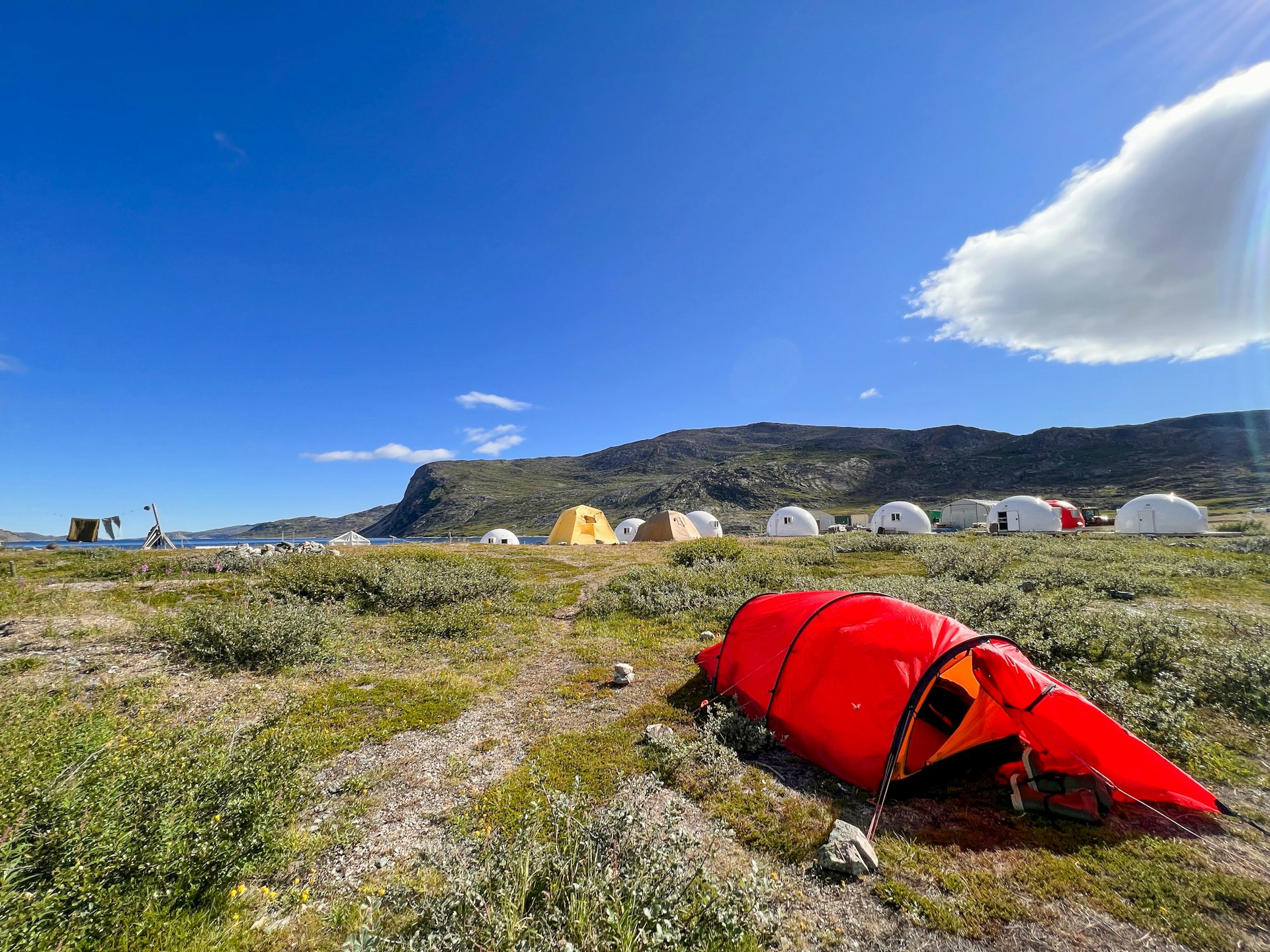
Where Knowledge Keepers and researchers meet
Soon we lift off again, banking hard left with a stomach-dropping lift over a mountain ridge. Within minutes, a sprinkling of white, orange and green geodesic domes, octagonal glamping structures, and larger utilitarian buildings appear in the valley below, near the water’s edge. This is the Torngat Mountains Base Camp and Research Station, arguably one of the most remarkable meeting places on earth.
Formed in 2006, this subarctic outpost sits just outside the Torngat Mountains National Park southern boundary on Labrador Inuit Lands. It is a joint venture between Air Borealis and Nunatsiavut Group of Companies, in cooperation with the self-governing Inuit Nunatsiavut Government. It was created to offer an accessible home base for visitors — some non-Inuit, but more so Inuit elders and their descendants returning to reclaim their connection to their homeland. It’s also a meeting place for Inuit Knowledge Keepers, Inuit researchers and scientists from around the world to collaborate on environmental and archaeological work. National park staff also operate from here each summer. Formed in 2008, Torngat Mountains is one of Canada’s newest national parks and the only national park run entirely by Inuit.

A tall electrified fence surrounds our enclave, armed each evening with 15,000 volts to protect us from a thriving polar bear population, as well as very large, very opportunistic black bears unique to Northern Labrador. Parks Canada Media Officer, Lindsey Moorehouse, warns us, “Don’t touch the fence, hang laundry on it, or most important, explore beyond it without the protection of an armed Inuit Bear Guard.” And with that, Inuit Bear Guards Joe, Maria, and others will not leave our sides for the next three days. It’s comforting, but begs again that big question — how can we 550 or so travelers, from late July to early September, be anything more than helpless observers amid an enclave of others with a clear important purpose?

Coming together in the visitor’s tent
Beyond the research lab, this week there’s Parks Canada staff, a youth program, Knowledge Keepers, Bear Guards, camp staff, and the Torngat Mountains National Park Co-Management Board holding annual onsite meetings. Returning elders also serve as Cultural Ambassadors, connecting everyone to Inuit ways of the past. We visitors are thrown into this mix over group meals, around the fire pit, noshing on char sandwiches on mountain hikes, helicoptering to 3000ft waterfalls and this first evening, at a researcher’s presentation.
The MASH-style visitor’s tent is standing-room only. Dr Robert Way, Assistant Professor in the Department of Geography and Planning at Queen’s University in Kingston, Ontario, describes his observations on permafrost loss at a site in the park, causing sloughing of soil into Torngat waterways. Inuit elder Sammy Unatweenak weighs in. “I remember no melting for 30 years here and now there are big changes.” Other elders speak up too. They share generations of understanding that puts findings of visiting scientists into a bigger picture. The mutual respect is palpable.
Later, I’ll watch veteran Inuit researchers measure environmental contaminants with the help of youth group volunteers. Innards are scooped from open char bellies on the stainless-steel lab counter. This is the domain of Manager of Research Michelle Sanders. She’s the first Inuit woman in this position, and she leads an all-women Inuit research staff.
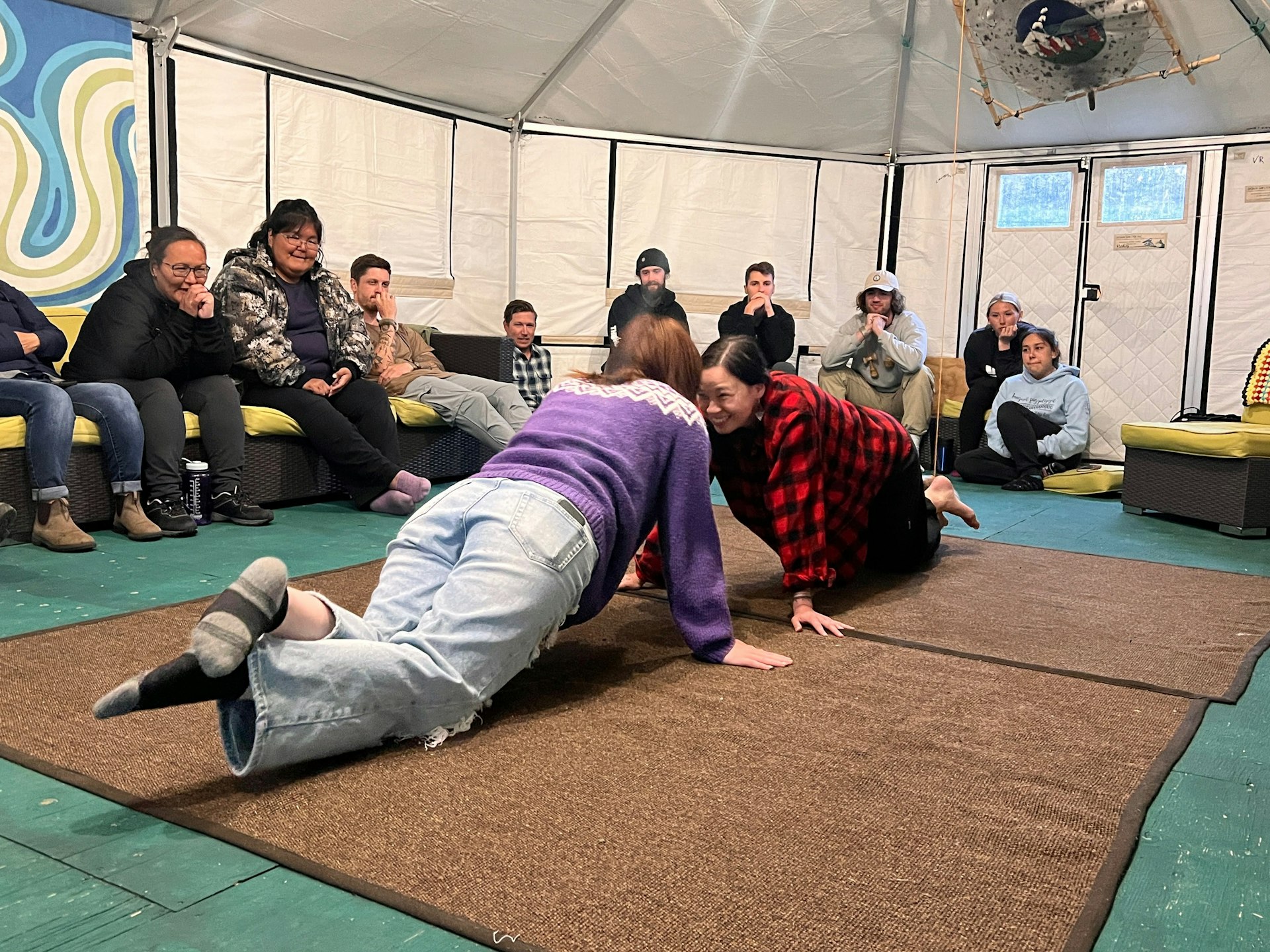
“There’s definitely been a shift [in how we work] from even from 10 years ago,” says Michelle. “We now guide visiting researchers’ work and we do the work ourselves.” But beyond their new path of self-determination, Sanders says her team also brings a completely different perspective to southern researchers: “It’s the Inuit way of life, everything is connected. So health is connected to land, to mental health. We take a holistic approach to research.”
It’s good to see that our tourism dollars are supporting such work. Still, I’m left again with that feeling of being just a spectator, an outsider amidst this community of reconciliation. Before arriving, I researched the Canadian government’s tragic history with the Northern Labrador Inuit, with the hope that knowing the context would somehow explain my presence. But, it is one thing to know facts, it is quite another to experience what all this means today — to the people involved, in the place where it happened — and to learn that the ways people want to tell their stories is entirely up to them.
I learn this firsthand from Maria.
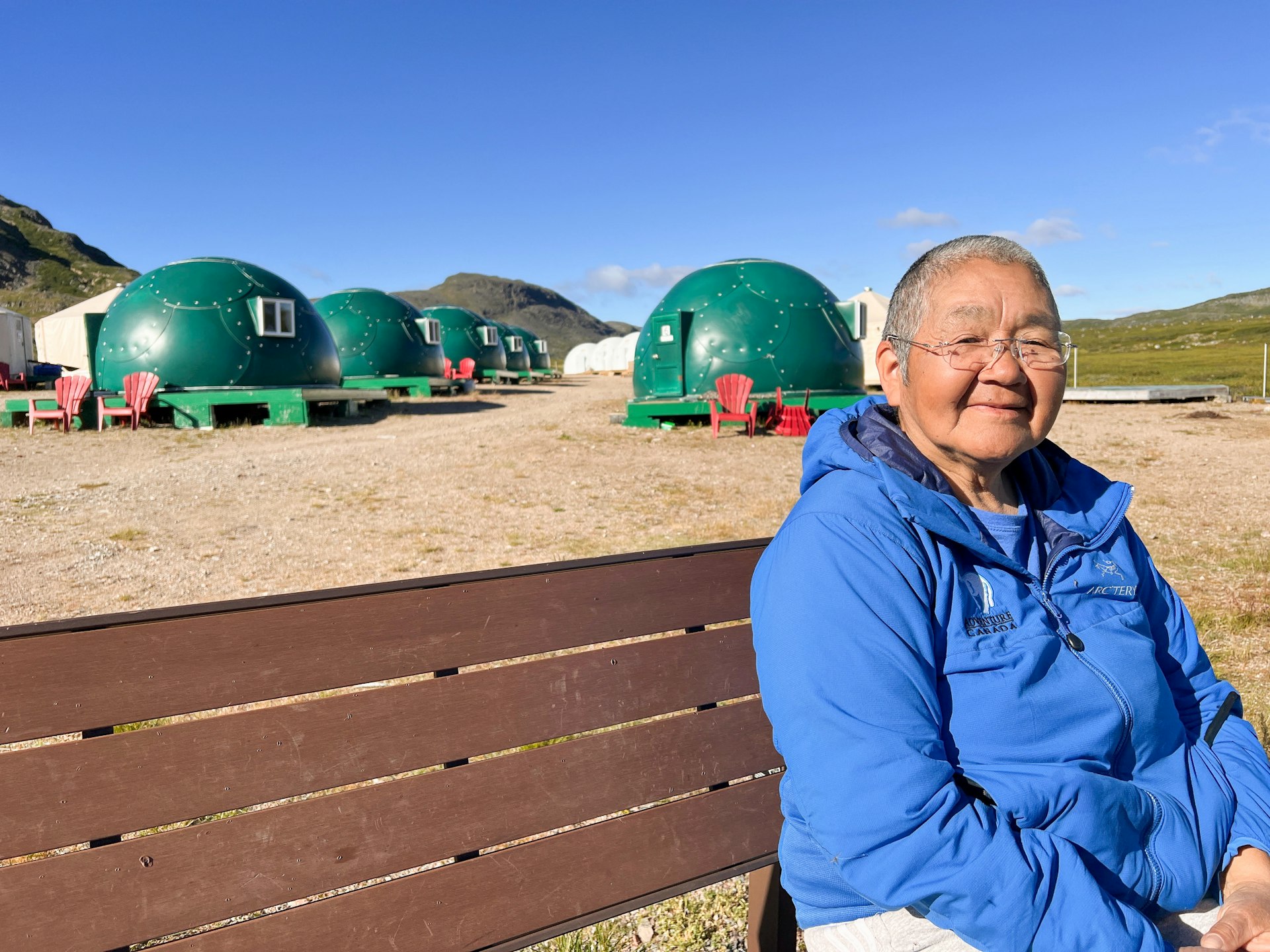
The tragedy of relocation
Maria Merkuratsuk’s ancestors thrived year-round living nomadically in this mystical landscape for thousands of years. This halted with her parents who were among many Northern Labrador Inuit relocated to the German Moravian mission in nearby Hebron in the early 1950s. The Hebron mission, dating back to 1818, has a complicated history. It was one of eight missions in Northern Labrador seeking to expand the reach of Christianity to Northern Inuit. Still, Hebron has been long known to Inuit as The Great Bay – an ancient meeting place and hunting ground for Northern Inuit communities. Here, Maria’s father and others stayed connected to their way of life, to the homeland they knew.
The deeper tragedy began in 1959, when suddenly, brutally, the entire Hebron community was dispersed to unfamiliar communities farther south. Families and friends were broken apart, transplanted to settlements where they had no connection to the land, to their culture. Maria’s father never recovered and she grew up absorbing his trauma.
Over dinner, I try this first night to chat with Maria, to learn more about what happened to her family. But she prefers to keep her distance. Later, some staffers suggest that maybe tomorrow she’ll take a few minutes with me on our long voyage to North Arm. We’ll see.

Inuit Captain Willy Fox welcomes us aboard his trawler Safe Passage on a cool misty morning. Born and raised in Nain, he’s navigated these waters for over 30 years. Today he helms our voyage deep into dramatic fjords, edged by ancient mountains that define this vast park. The scenery ahead is awe-inspiring. Still, it’s the chance to explore this homeland through the eyes of those reclaiming their roots here that will leave us forever transformed.
Below deck, an Inuit Parks Canada staffer sews seal skin booties for a friend’s baby. Lindsey sips tea at the same table. She’s been working here for seven seasons. And like so many others onboard, she too is reconnecting with her roots.
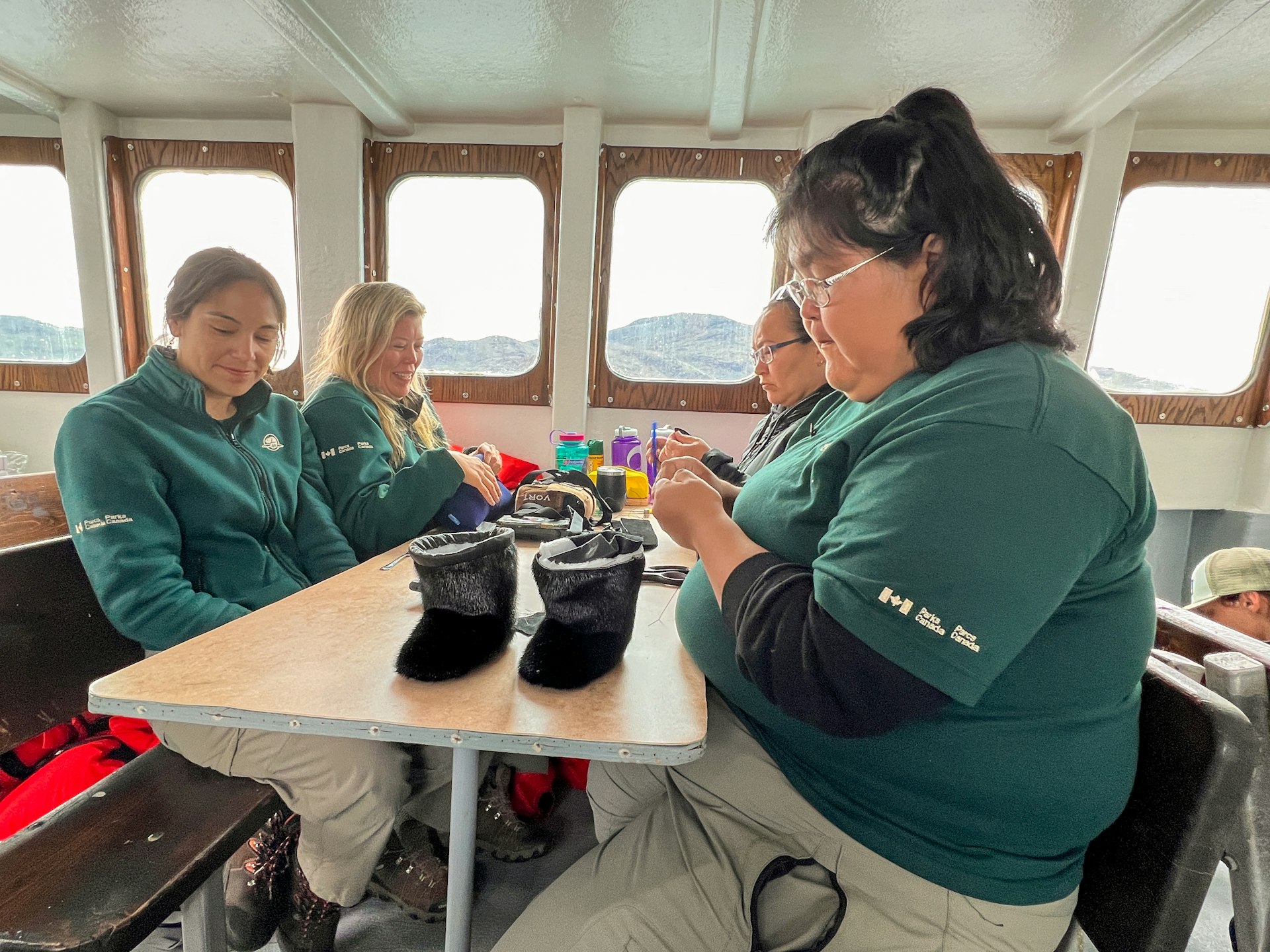
“It instills such a sense of strength in me knowing that my ancestors lived this life away from modern amenities, and they were strong and intelligent enough to thrive,” she beams. “And in one of the most amazing places on earth.”
Maria soon appears down below too. I ask her to chat over tea, but she insists today her stories are for the group. Fair enough. Later, I find her topside talking about polar bear hunting, mermaids and other tales of growing up along these shorelines. I join the researchers, camp housekeepers, and Parks Canada staffers listening in. We’re spellbound.

Wildlife sightings
Later, at the head of the North Arm channel, someone spots a polar bear napping on the beach, about 100 yards from where we’d planned to land. Maria bolts to the bow of our 45-ft trawler, cocks her rifle and tells our group of 20 or so to cover our ears. Her warning shot echoes off the 3000ft mountains flanking the fjord. The two zodiacs helmed by fellow Bear Guards race ahead to push the animal far up the shoreline with bear buzzers that look and sound like misfired fireworks. The bear runs, but then stops and looks back.
“He’s not well,” says Maria. “He should be more afraid.” I ask her how that might affect the bear’s behavior. She replies with a devilish grin. “He wants to eat you.” Clearly, she and her fellow Bear Guards have this covered. And that’s because this otherworldly, 3700-sq-mile park is no wilderness to them. It’s their homeland. Indeed, Maria, Joe and others expertly push off the unwell bear far from our landing site. Only half joking, I wonder out loud, “How far is far enough?”
And then the fun carries on like nothing happened.

Park staffer Stephanie casts once from the beach and pulls in a huge char. Others do the same. Within minutes, fish are gutted for frying. Fires are going. Maria mixes up a batch of traditional fried bread called panitsiak. They’re at once perfectly doughy and crispy. Someone dubs them Northern Labrador croissants.
From the beach, Bear Guard Joe leads us, rifle in hand, single file through an active archaeological site with tagged artifacts, some thousands of years old. Beyond a meadow of blueberries and wildflowers, over the next rise, we climb to the edge of a gushing waterfall then down into a sparkling clear swimming hole. Further on is a huge lake and across the valley, another even higher cascading stream.
Still, even amid this panorama, the true marvel is the ease and innate sense of belonging of our Inuit hosts, guiding us safely, sharing their bond with this harsh wild beauty. I realize, being physically here with Lindsey, Joe, Maria and the others is the only way to imagine the unspeakable loss of being torn away from it all.
These are the stories that I’ll hear tomorrow.
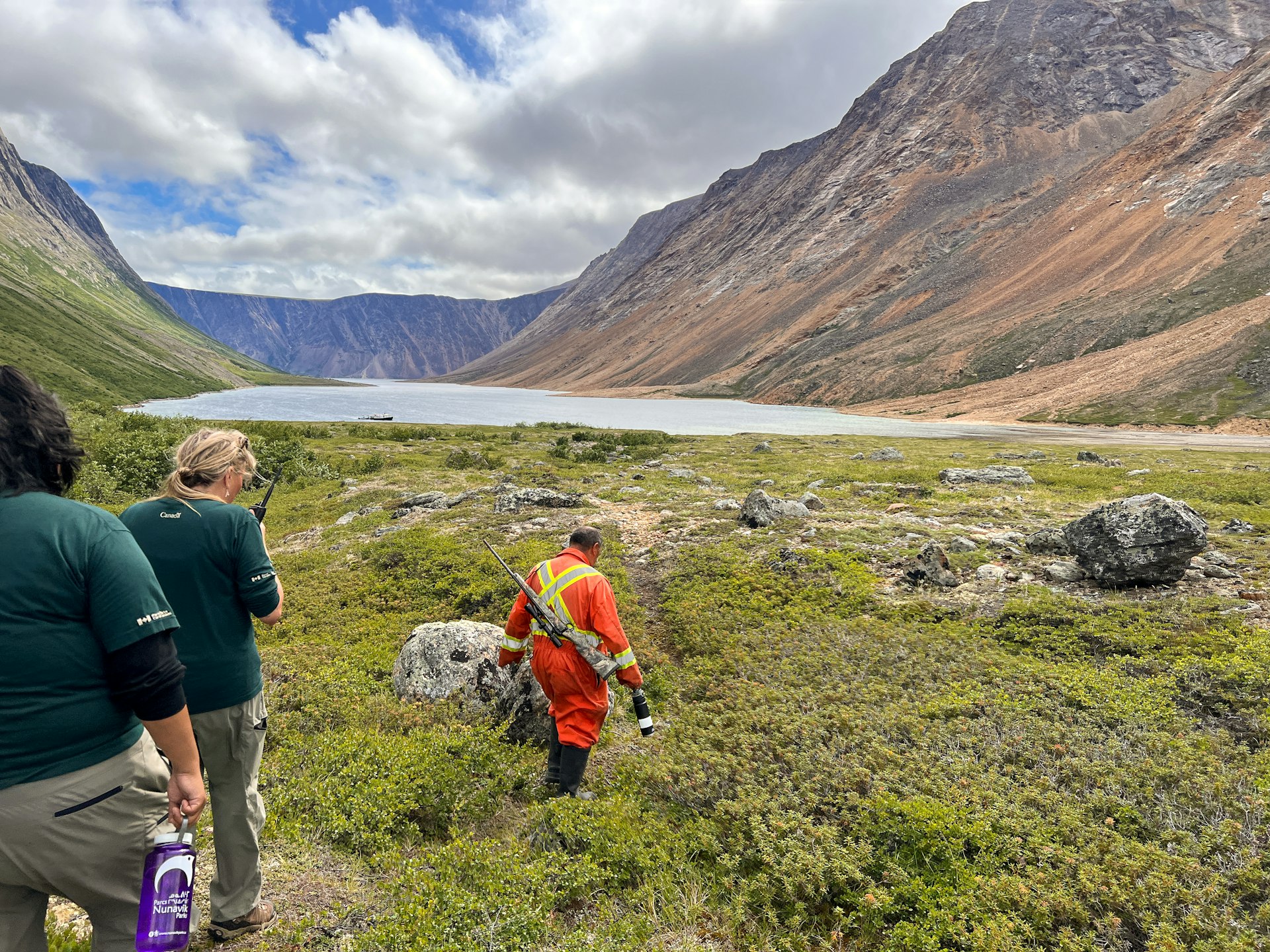
Sharing the stories of loss — and hope
I learn Maria isn’t coming to Hebron. Maybe I’ll catch her later. While early morning is bright and clear, we’re told high winds will hit by noon — too rough for Willy’s longliner. I grab my gear and head to the helipad.
We touch down about 25 yards from the long white Moravian Church at Hebron, about a 15-minute helicopter ride south of Base Camp. The circa 1831 structure looks freshly painted. Two hours here is not enough – there are so many people with so many stories.
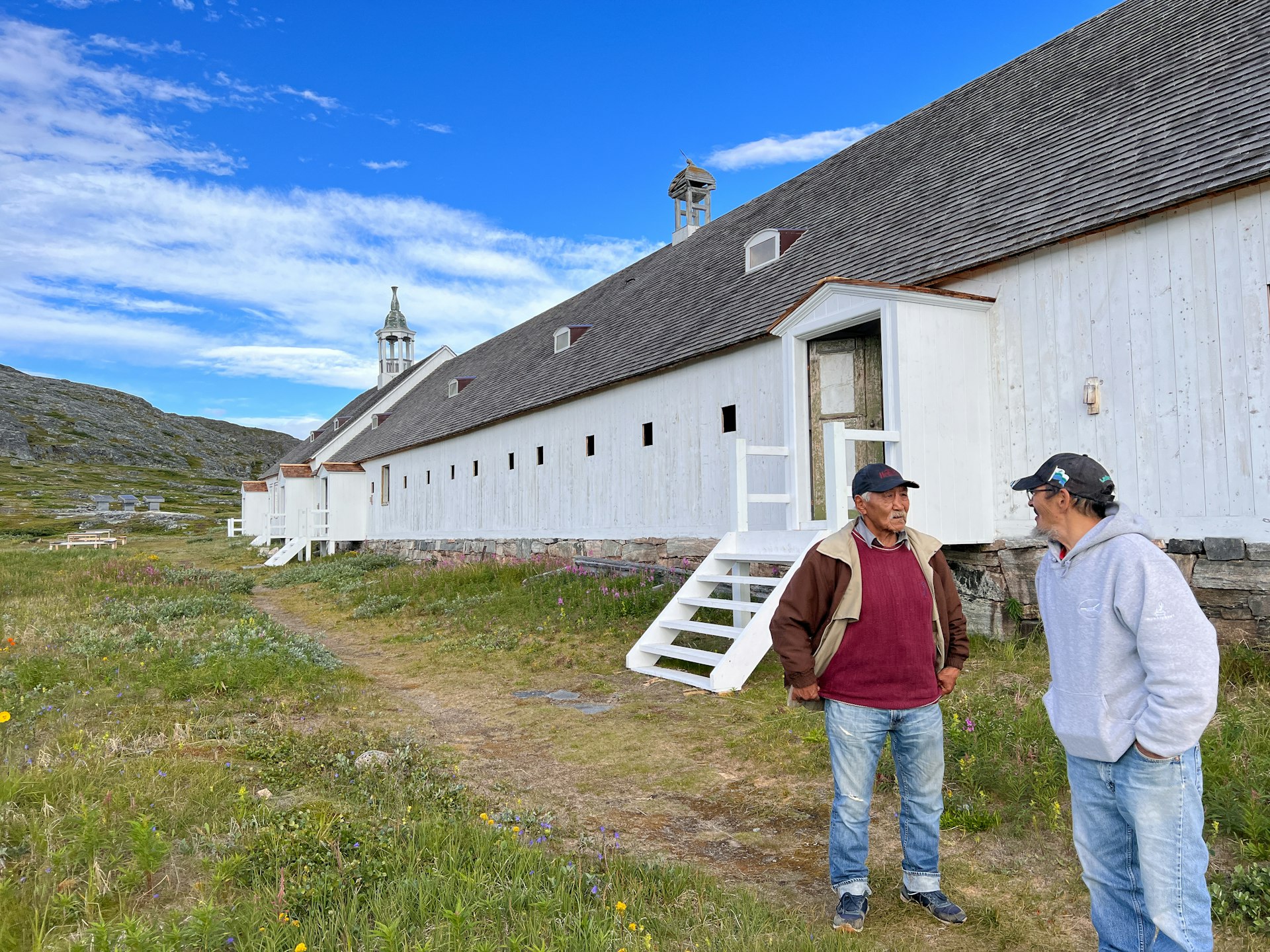
Cultural Ambassador Gus Semigah is waiting at the church steps. Gus was born on Hebron and helped with the church restoration beginning in 2002. He guides us through the post office and the teacher’s quarters. From the belltower, we see at the shore the gray skeleton of an old blubber house and the collapsed ruin of the Hudson’s Bay store, slowly being reclaimed by nature. Our conversation ends in the sanctuary.
“There were a lot of people who didn’t want to leave here, but they had nothing to say,” Gus explains. “They had the meeting inside the church because people can’t argue with anybody here. The government and the ministers at the meeting knew this.” Calculated and heartless, the goal was to remove this Inuit community from the island with the least resistance possible.
From the church, Gus says goodbye. I walk inland toward a small cabin. Outside, Lena Onalik waves hello. Lena is an archaeologist for the Nunatsiavut Government and leads the Hebron Family Archaeology Project. She’s been hosting a small group of elders this week.
“It’s a race against time to bring relocated elders back, to share their stories,” she says. “While we’ve been here, two more elders have passed on. There’s less than 85 left.”
Soon gunshots announce the departure of the elders and she races to the shore to say goodbye. One elder, however, is staying behind.

Ambassador Sophie Keelan was born in 1948 on Sallikuluk or Rose Island in Saglek Bay — a sacred place for Northern Labrador Inuit. She greets me with a warm smile then suggests we walk back to the church to chat.
We sit at a small table where the pulpit would have been. “We were living like nomadic Eskimos at the time,” she begins, using the archaic term still utilized by some elders. Sophie was five when the missionaries insisted her parents bring their children to Hebron for schooling. Family allowances would be cut off if they didn’t comply. She doesn’t remember her family’s nomadic days, but she is one of the dwindling few who recalls their joyful life on Hebron — and the pain of being forced to leave when she was 11 years old.
“The brass band was playing a going-way hymn. When we got on the ship, women and children were crying. I was crying. The captain started playing his accordion – ‘Amazing Grace’ – and we were looking up, trying to see our home. We watched it to the very last. Until there was no more Hebron.”
I ask Sophie how important it is for elders like her to come back.
“It has to happen,” her voice trembles. “We were all from Northern Labrador. We originated from here. And it’s our homeland. It’s important that they bring it back,” she pauses, holding back tears. Sophie gives me a warm embrace. I can’t delay my departure any longer. The winds are picking up.
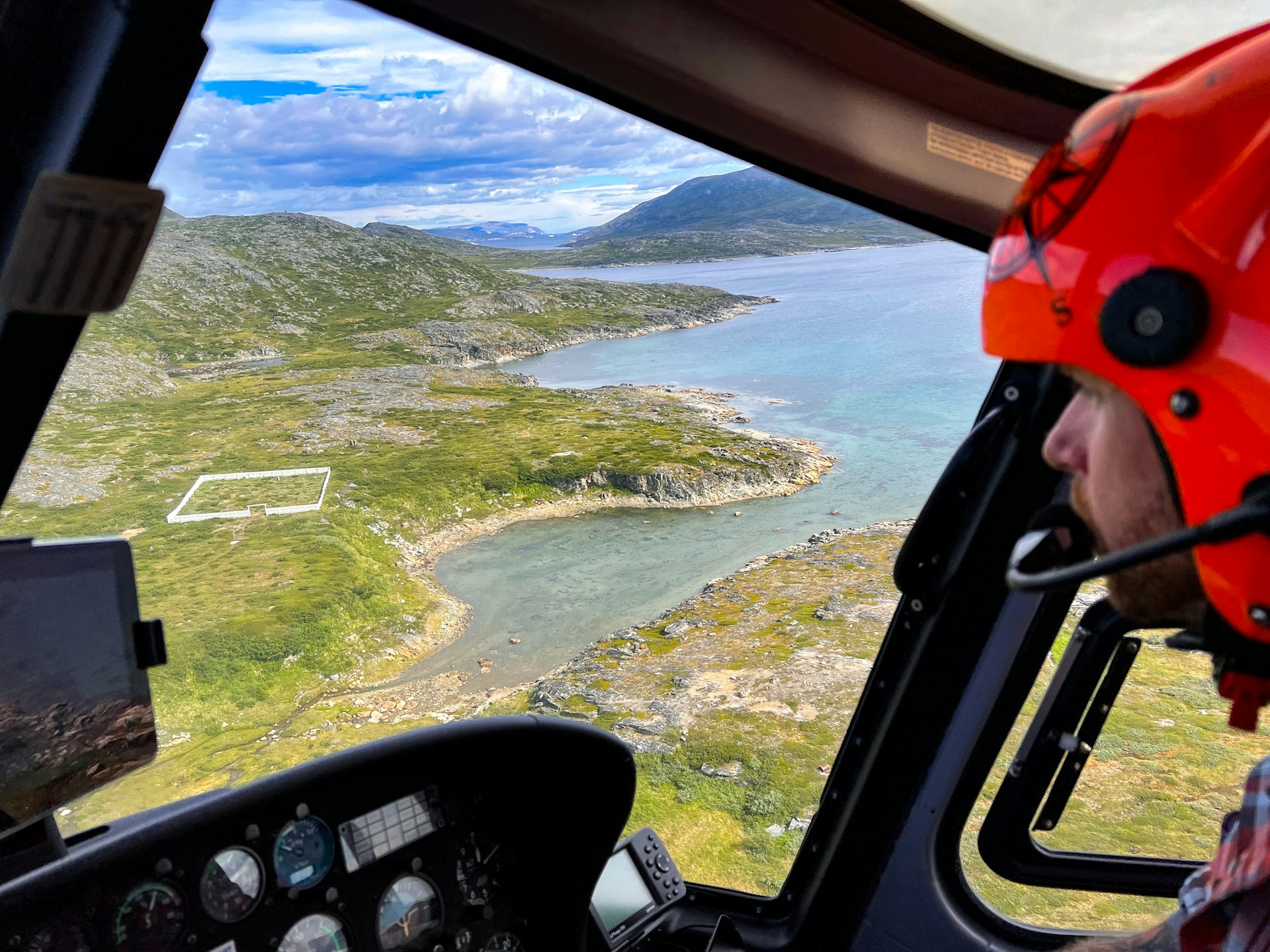
As our helicopter lifts us away. I look down on the square, white-fenced area marking Hebron’s graveyard. It’s the once abandoned resting place of loved ones of so many people I’ve met this week. I see the plaques with names of all Hebron residents relocated, next to a formal apology. There’s also an Inuit response on these plaques. It ends with the words, “We forgive you.”
It’s our last night at Base Camp. I’m resigned that perhaps Maria would prefer not to talk. I’ve learned over the past few days, everyone processes the suffering of the past here differently. But then, over dinner, she taps me on the shoulder with a plan.
The next morning, we meet by the fire pit, only 40 minutes before my helicopter lifts off to Saglek Bay, the beginning of my journey home.

“It’s a very long story,” Maria begins, still hesitant. “And in the end, it all relates back to when my dad was relocated from Hebron.” What follows is a story of loss of belonging, loss of self, of deep generational trauma, then of remarkable hope and strength. She begins describing the devastating impact of her father, being forced from his homeland in 1959 and relocated to communities where he had no connection to the people or the land. She says he never recovered. “My father was so hurt and angered. He lived through the rest of his life and died feeling like something was against him all the time.” She continues, “His hurt and anger carries on in my siblings, but for me, I’m tired of being angry.” Finally, I ask what being part of Base Camp and the relocation story here has meant to her. She pauses, takes a deep breath. “Talking about it today now helps me heal,” Maria says. “And I am learning to forgive what was done to my family, so I can live my life in a good way.”
Buckling up in the helicopter, I ponder how Maria and so many here have unveiled to me this Place of Spirits. And I think how each has patiently and authentically shown me at least one simple purpose in my coming here — to bear witness, no filters, to the beauty and the darkness, to the ongoing despair and astounding resilience, all happening at once in this extraordinary community. As Base Camp disappears behind the mountain ridge, I’m filled with gratitude to have been part of it all, even for a few days.
The Torngat Mountains Base Camp and Research Station 2023 season runs from late July to early September.
